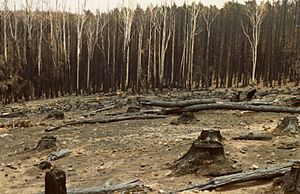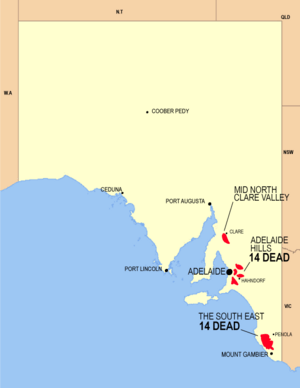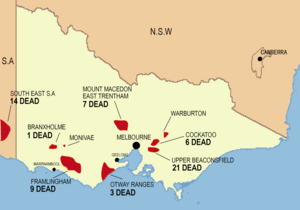Ash Wednesday bushfires facts for kids
Quick facts for kids Ash Wednesday bushfires |
|
|---|---|

Aftermath of the 1983 Ash Wednesday bushfires at Mount Macedon
|
|
| Location | Australia: Victoria and South Australia |
| Statistics | |
| Date(s) | 16 February 1983 |
| Burned area | 2,080 km2 (513,979 acres) in South Australia and 9,954 km2 (2,459,687 acres) in Victoria on one day. 5,200 km2 (1,284,948 acres) burnt throughout the 1982/83 season. |
| Cause | Faulty powerlines, arson, and negligence after years of extreme drought |
| Land use | Urban/rural fringe areas, farmland, and forest reserve |
| Deaths | 75 (47 – Victoria) (28 – South Australia) |
| Non-fatal injuries | 2,676 |
The Ash Wednesday bushfires were a series of very serious bushfires. They happened in south-eastern Australia on February 16, 1983. This day was called Ash Wednesday in the Christian calendar.
In just twelve hours, more than 180 fires started. Strong winds, blowing up to 110 kilometers per hour (68 mph), spread them quickly. These fires caused huge damage across Victoria and South Australia. Years of very dry weather, known as a drought, made the conditions perfect for fires. It was one of Australia's worst fire days in 100 years.
These fires became the deadliest bushfires in Australian history at the time. This was until the Black Saturday bushfires in 2009. In Victoria, 47 people sadly lost their lives. In South Australia, 28 people died. This included 14 volunteer firefighters from Victoria and 3 from South Australia.
Many people died because of "firestorm" conditions. A sudden, strong wind change in the evening made the fires much worse. It also changed their direction very quickly. The flames moved incredibly fast and were very fierce. There was a lot of dry fuel, and smoke filled the air. This made it impossible to stop the fires.
Often, people had to protect themselves. The fires cut off communication, escape routes, and even electricity and water. About 8,000 people had to leave their homes in Victoria. South Australia declared a state of disaster for the first time ever. More than 35 homes were burned in one small town in Victoria.
Ash Wednesday was one of Australia's most expensive natural disasters. More than 3,700 buildings were destroyed or damaged. About 2,545 families lost their homes. Many animals also died. Over 340,000 sheep and 18,000 cattle were lost. Many native animals also perished. The total cost was estimated at over A$400 million in 1983. This would be about A$1.3 billion today.
During this emergency, many volunteers helped. Around 130,000 firefighters, defence force members, and relief workers came from all over Australia.
Contents
Why the Fires Happened
Fires in 1980
On Ash Wednesday in 1980, there were also bushfires in South Australia. These fires swept through the Adelaide Hills. They destroyed 51 houses. People called these the "Ash Wednesday" fires until the much bigger fires in 1983.
The El Niño Effect
By the end of 1982, a long drought had hit eastern Australia. This drought was caused by a natural weather pattern called El Niño. In many places, there was very little rain. Some areas had only half the usual rainfall since the 1870s.
In November, Melbourne had strict water limits. On November 24, Victoria announced a Total Fire Ban. This was the earliest ban in forty years. By February 1983, Victoria had 75% less rain than usual. The first week of February was extremely hot. Record high temperatures were set on February 1 and 8. All these dry and hot conditions made the forests around Melbourne and Adelaide very dangerous for fires.
Early Fire Season Warnings
Even before February 16, fires were already causing problems in Victoria. Firefighting agencies hired extra staff. They also prepared more equipment and aircraft. The first big bushfire happened on November 25, 1982. More large fires followed in December.
An ongoing fire near Cann River had been burning for almost a month. On January 8, a big fire near Bacchus Marsh killed two forest workers. On February 1, a fire burned part of Mount Macedon. Fifty houses were destroyed. These early fires were already using up many firefighting resources. In the 1982/83 season, Victoria's CFA responded to 3,500 fires.
Dust Storms
An unusual event happened on February 8. Melbourne was covered by a giant dust storm. This dust cloud was over 300 meters high and 500 kilometers long. It was made of about 50,000 tonnes of topsoil. This soil came from the very dry Wimmera and Mallee areas. The dust storm made it almost dark in Melbourne for an hour. It cut visibility to just 100 meters.
There was also a dust storm in Adelaide on the day of the bushfires. These dust storms showed how incredibly dry the land was.
The Day of the Fires: February 16
Wednesday, February 16, was another extremely hot and dry day. Early in the morning, the weather seemed complicated. Hot, dry air came from inland Australia. Cooler air moved in from the ocean. In front of the cooler air were strong, hot winds blowing from the north.
Temperatures in Melbourne and Adelaide quickly went above 43°C (109°F). Winds blew in gusts up to 100 km/h (62 mph). The air was very dry, with humidity as low as 6 percent. By mid-morning, the fire danger was extremely high. It was one of the worst fire weather days in south-east Australia since the terrible Black Friday bushfires in 1939.
The first fire was reported at 11:30 am near McLaren Flat, south of Adelaide. Within hours, emergency services in Victoria and South Australia received many fire reports. In Victoria alone, 180 fires were reported. Eight of these became very large. At one point, fires surrounded the entire city of Melbourne. Homes began to burn early in the afternoon. This happened especially in the Adelaide Hills and the Dandenong Ranges.
Many historic homes in the Mount Lofty Summit area were destroyed. People lost everything they owned. Many houses in this area did not have main water supply. They relied on rainwater tanks and pumps. The extreme heat made these pumps useless. Over 60% of the homes lost in South Australia were in the Mount Lofty Ranges. Of the 26 people who died in South Australia, 12 were in city areas. This included four in the Adelaide suburb of Greenhill.
The Dangerous Wind Change
The most devastating part of the Ash Wednesday fires happened just before nightfall. A fierce and dry wind change swept across South Australia and Victoria. This sudden change dramatically shifted the direction of the fires. It also made them much more intense.
The long lines of flames, pushed by strong northerly winds all day, were suddenly hit by powerful south-westerly winds. These winds reportedly moved faster than 110 km/h (68 mph). The fires turned into huge fire fronts, many kilometers wide.
The strength of the wind change created an unstoppable "firestorm." This produced tornado-like "fire whirls" and fireballs of eucalyptus gas. These fireballs were over three meters across. Survivors said the sound of the fire front was like a jet engine, but much, much louder. The sudden change in temperature and air pressure was so strong that houses were seen exploding before flames even touched them. One person described it as "a monster."
The strange conditions caused unusual effects. A car was pushed 90 meters along a road with its handbrake on. Burning mattresses flew through the air. Road surfaces bubbled and caught fire. Sand even melted into glass. Experts later said that the heat of the fires, after the wind change, reached 2000°C (3632°F). This was hotter than many other fires. The Ash Wednesday fires released a huge amount of heat energy.
Whole towns were destroyed in minutes. In the Dandenong Ranges, the villages of Cockatoo and Upper Beaconsfield were devastated. Twelve volunteer firefighters died there. They were trapped by a wall of flame when the wind changed. Parts of Belgrave Heights and Belgrave South also lost many homes.
Most of Macedon and much of historic Mount Macedon were burned. This included many old mansions and famous gardens. The morning after Ash Wednesday, popular coastal towns like Aireys Inlet, Anglesea, and Lorne looked like barren landscapes. The fire on the coast was so intense that firefighters had to let it burn until it reached the ocean. It destroyed everything in its path.
In total, about 2,100 square kilometers (518,921 acres) burned in Victoria. About 2,080 square kilometers (513,979 acres) burned in South Australia. Across the entire 1982/1983 summer, about 5,200 square kilometers (1,284,000 acres) were burned by bushfires.
What Happened After
Many fires in Victoria were thought to have started from sparks. These sparks came from power lines touching each other or tree branches. After the fires, a careful review of fire safety was done. Areas under large power lines were cleared. Older power lines that were at risk were replaced with safer ones.
In South Australia, an investigation into the fires found that the communication systems for the Country Fire Service were not good enough. Because of this, a new government radio network was planned. However, it took almost 20 years to install. The Bureau of Meteorology also improved its weather forecasting. They focused on predicting wind changes.
A new emergency plan, called Displan, was also created. Many lessons were learned from these fires. These lessons helped in building safer homes and managing bushland better. They also improved emergency response. These lessons were very important in later crises, like the 1994 Eastern seaboard and 2003 Canberra fires.
A study looked at the 32 people who died in Victoria (not including firefighters). It showed that 25 of them were outside their homes. Several died in vehicles while trying to escape. The study found that waiting until the last minute to leave was a common mistake.
Lasting Impact
Until the 2009 Black Saturday bushfires, Ash Wednesday had the highest number of deaths from a bushfire disaster, with 75 fatalities. For 25 years, Ash Wednesday was the standard for all bushfire emergencies in Australia. Since 2009, lessons from Black Saturday have also been added. Ash Wednesday is still known as one of Australia's worst natural disasters.
Many studies were done after the fires. They found that the events caused posttraumatic stress disorder (PTSD) in many people. This was true even 20 years later.
The importance of Ash Wednesday was clear in 2008. Its 25th anniversary received a lot of public and media attention. Memorial sites have been built in the areas hit hardest by the fires. Museums have also held exhibits where survivors could share their stories.
Areas Affected in Victoria
| Area/downtown |
|
|
|
| Cudgee & Ballangeich |
|
|
|
| Otway Ranges |
|
|
|
| Warburton |
|
|
|
| East Trentham & Mount Macedon |
|
|
|
| Belgrave Heights & Upper Beaconsfield |
|
|
|
| Monivae |
|
|
|
| Cockatoo |
|
|
|
| Branxholme |
|
|
|
|
|
|||
See Also



